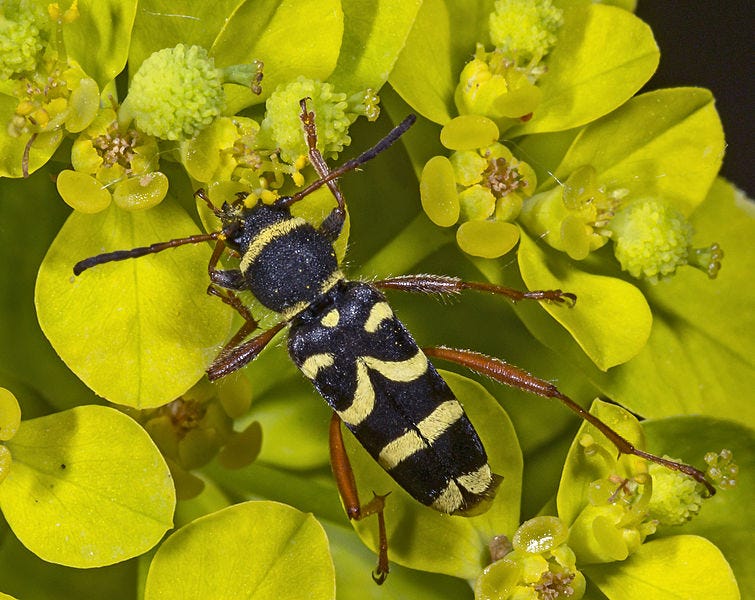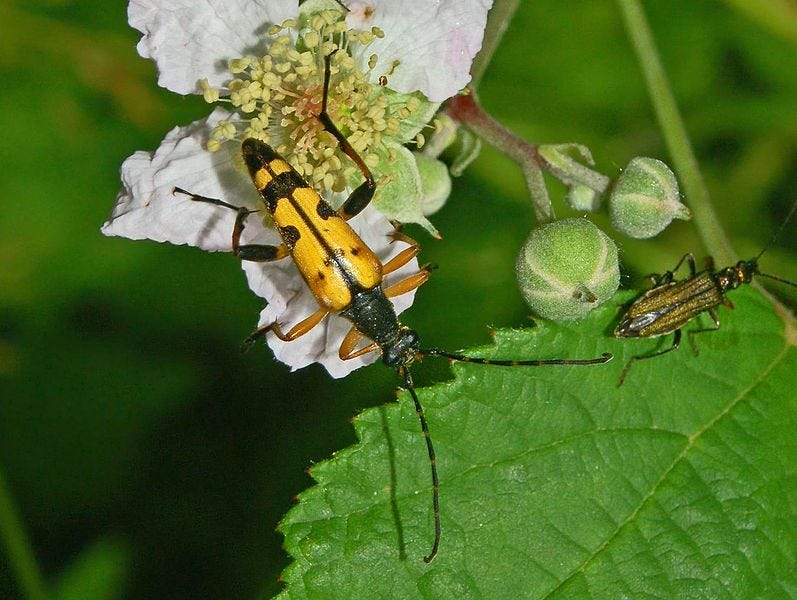
After looking at the title and the above photo, you might be thinking, ‘Bees again? Didn’t you talk about them in that pollinators story?’ You are correct that we’ve discussed bees and the mutualistic relationship they have with flowering plants and we will be talking about them again today. However, the bees aren’t our main focus. As you can see from the caption, that is not a picture of a bee. Rather, it is a species of hoverfly. Hoverflies are insects that form the taxonomic Family Syrphidae. There are over 6,000 known species of hoverfly worldwide and the majority are mimics.
Most hoverfly species look very similar to bees and wasps, with their yellow and black or brown spots and stripes. Like bees, they are important pollinators and got their common name from their tendency to hover around flowers. However, they are not closely related to bees at all, but belong in the Order Diptera, the flies. Bees are part of Hymenoptera, which also includes wasps and ants.
Hoverflies are ubiquitous, and can be found on every continent except Antarctica (not exactly well-known for either its flowers or its insects). They have no stingers or other anti-predator defense mechanisms and are entirely harmless. Instead, they avoid harm by mimicking bees and wasps, which do have such defenses. However, they are not the only group to do so. There are bee and wasp mimics belonging to the beetle Order, Coleoptera. These include the wasp beetle, Clytus arietis, (top of pair below) and the spotted longhorn beetle, Rutpela maculata, (bottom of pair below). The wasp beetle even emits a wasp-like buzzing sound when threatened. Remember that mimicry does not have to be limited to visual cues. Auditory mimics exist as well.


These two species are also pollinators and can frequently be seen on or near flowers. This is a wonderful example of the concept of convergent evolution, when two or more unrelated groups both develop similar traits independently. The strategies of pollinating mutualism and bee/wasp mimicry pair well together. Therefore, selective pressure in both flies and beetles would favor those individuals in pollinator species that most resembled their more dangerous counterparts. The better the mimicry, the less likely that the mimic would be recognized as harmless and consumed. Thus, each group developed its color pattern separately for similar reasons, instead of having a common ancestor that expressed that pattern already.
Such patterns can be seen everywhere, such as in the various adaptations for aquatic movement found in fish and marine mammals. It is also true for other mimic interactions with more than just two species. It is less likely that more distantly related species common from an ancestral mimic than that they individually became mimics over time because mimicking individuals survived longer and produced more offspring.
Now, just like in last week’s story, imagine that you are a predator that feeds on insects. In the past you have received a nasty sting from a bee or wasp and so you avoid anything with similar patterns as a precaution. Do you think you would be able to tell the difference between the mimic and the real thing? Would such a risk be worth it?
Invariably, such risks are, in fact, not worth it. Thus, hoverflies and wasp beetles gain the benefit of the wasp and bee predator avoidance signalling, without having to expend the energy required to produce the actual venom. That energy is not insignificant, as both bee and wasp venoms are a highly complex mix of proteins, peptides, and acid or alkaline compounds. These all contribute in different ways, often at the cellular level, to the discomfort of a sting. They can destroy cells or break open cell membranes. However, these are not deadly to humans in and of themselves. On average, 53 people die in the United States from bee stings every year because of an allergic reaction leading to anaphylactic shock. Bee sting allergies are the result of the body overreacting to the foreign substance.
The point of the sting is not necessarily to kill the target, but to dissuade it from attacking the bee or wasp hive. Smaller targets can die, but larger ones can simply be encouraged not to repeat the actions that triggered the sting in the future. Defensive mimics take advantage of this strategy so that individuals that learn to leave the dangerous model species alone will also leave alone the harmless mimic species. In fact, if the sting were deadlier, it would be more difficult for mimic species to succeed at this strategy (most organisms do not have an innate knowledge to avoid certain hazardous species). Negative situations must first be experienced so that an individual can learn to avoid similar circumstances at a later time.
If you like my stories, please like, subscribe, and share them. If you have an idea for a topic for a future season, let me know and if I use it, I’ll give you a shout out in my introductory post.